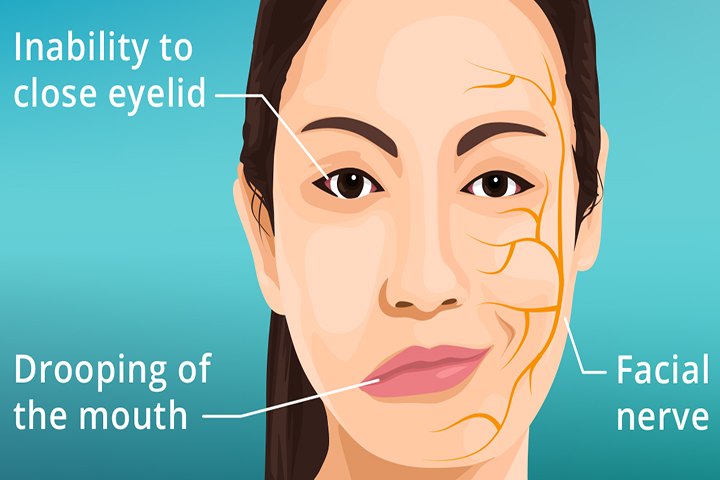Bell’s Palsy is the temporary paralysis of the facial muscles. This paralysis is usually accompanied by weakness and maybe twitching, but only on one side of the face.
This is due to the trauma of the seventh cranial nerve (the facial nerve), and symptoms are typically only temporary.
It’s not uncommon to see Bell’s Palsy in people who are diabetic or are recovering from a viral infection.
Food & Nutrition Diet (Meal Plan) for Akathisia
#1 Recommended Breakfast Diet for Bell’s Palsy

Since this condition is caused by inflammation, patients should stick to anti-inflammatory foods.
It’s also important to get adequate vitamins and minerals, especially at the start of the day. An example breakfast for Bell’s Palsy includes whole-grain toast with eggs and some fruit, such as an apple or a pear.
For something lighter, try yogurt and pineapple or a bowl of fortified cereal (go for a whole-grain variety) and a banana.
#2 Recommended Lunch Diet for Bell’s Palsy

Veggies are always a good choice, but people with Bell’s Palsy need to be careful. Certain veggies contain arginine, which can make infections and symptoms worse.
Avoid brussel sprouts and tomatoes, but fill up on other veggies because they’re full of fiber and antioxidants.
Asparagus and green beans have L-lysine, which renders infections dormant.
Meats also contain this amino acid, although patients should stick to lean meats since too much fat in the diet can exacerbate symptoms.
Omega-3 fatty acids support brain and nerve functions, so they’re a crucial component to a healthy diet. Sources include anchovies, salmon, and sardines.
However, omega-6’s can have pro-inflammatory effects.
#3 Recommended Dinner Diet for Bell’s Palsy

Green vegetables are full of Vitamin A that patients need, so a plate full of them is a good place to start.
Leafy veggies also contain Vitamin C, as do potatoes and peppers.
For some extra nerve-repairing zinc, patients can add some beans, poultry, or seafood. This way they’ll get their protein fix, too.
Whole grains also have zinc, and they can help to round out the evening meal.
#4 Recommended Snack Diet for Bell’s Palsy

Remember that Bell’s Palsy can make it difficult to chew on one side of the mouth because of the paralysis and loss of feeling.
This can make eating foods difficult, especially if they’re crunchy and require a lot of chewing.
Snack time should be enjoyable, not an extra chore, so try to opt for softer foods. Some suitable snack ideas might include a smoothie or yogurt.
The amino acid L-lysine causes infections to go dormant, so it’s a good idea to consume foods rich in it. Examples include cheese, milk, and yogurt.
Apples, apricots, avocados, pears, and pineapples also contain L-lysine.
Why not combine some of these fruits with some milk or yogurt?
#5 Recommended Drinks for Bell’s Palsy

Liquids can be particularly useful for patients who are having trouble chewing regular food. A smoothie can combine the nutrients of different fruits and veggies and will alleviate the need to chew.
Herbal teas are another option, particularly echinacea or elderberry for their antiviral benefits.
Water is always the healthiest choice, and patients can add some citrus fruits or berries in their water to spruce it up.
If drinking is difficult, a straw can make it much easier.
#6 Recommended Herbs for Bell’s Palsy

There are a few herbs that can lend some anti-inflammatory power to the cells. One example is capsaicin, which is in chili peppers.
Capsaicin can help patients with Bell’s Palsy better control any discomfort. Plus, it can help lower LDL cholesterol, which is always a good thing.
Garlic is another herb that patients would benefit from. Garlic reduces inflammation and it’s helpful in combating infections.
It’s an easy herb to slip into different meals, and it tastes good, too.
Finally, turmeric is known for its antioxidants and medicinal properties. It is antimicrobial, making it perfect for recovering from viral infections, and it has anti-inflammatory qualities.
People can take turmeric in tablet form if they don’t like the taste.
#7 Recommended Fruits for Bell’s Palsy

As mentioned earlier, fruits high in L-lysine are a great choice. Apples, apricots, avocados (it’s a fruit!), pears, and pineapple are prime candidates.
Berries, citrus fruits, and tropical fruits are also good options because they’re chock full of healthy Vitamin C.
#8 Recommended Vitamin/s for Bell’s Palsy

B vitamins have the power to control nerve cell activity, so it makes sense for a Bell’s Palsy diet to include these vitamins.
Many types of meat contain Vitamin B6, including salmon, tuna, grass-fed beef, and chicken. Bananas and spinach are also rich in this vitamin.
Beans and lentils will provide Vitamin B9, along with asparagus, broccoli, and turnip greens.
Eggs and shellfish are full of Vitamin B12, and getting a variety of B vitamins will ensure that patients reap the full benefits.
#9 Recommended Mineral/s for Bell’s Palsy

Besides getting adequate B vitamins, patients should try to get enough zinc in their diet. They can also take supplements if they can’t get enough of this mineral with food.
Zinc helps to kickstart nerve repair and cell growth, so it’s perfect for people with Bell’s Palsy symptoms. Besides supplements, zinc is in seafood and shellfish, pork, and some fortified cereals.
Alpha lipoic acid is a natural nerve repairer and can be especially useful for people with diabetic neuropathy. Patients can talk to their doctor about taking alpha lipoic acid supplements.
Copper is a mineral that helps a lot with nerve health. Copper is in beans, black pepper, leafy greens, potatoes, shellfish, and whole grains.
#10 Discouraged Foods for Bell’s Palsy

People with Bell’s Palsy should limit their intake of foods that contain arginine because it encourages virus cell growth.
Some foods that have arginine in them include different varieties of nuts and seeds, as well as brussel sprouts, blackberries, blueberries, grapes, and tomatoes.
Artificial colors and preservatives are also a no-go, as are alcohol and caffeine.
Of course, processed foods that are full of refined carbohydrates and added sugars aren’t good for anyone, especially those dealing with a medical condition.
Stick to the recommendations above to get the most of out of their nutrients and alleviate symptoms naturally.
*If you have any concerns or questions about your health, you should always consult your doctor before making any changes to your diet or nutrition program.
- READ MORE




